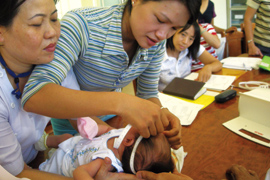The Mitsui & Co. Environment Fund
Introduction to Grant Projects
Kanazawa Medical University School of Medicine Associate Professor Muneko Nishijo
The construction of health risk monitoring systems from exposure to dioxins in Vietnam
Research grant
- Project Description
Due to the effects of defoliant spraying during war, and the exposure of the Vietnamese people to its main ingredient, dioxin, even now, 35 years later, it has been reported that the soil and lakes and marshes of highly-polluted regions, as well as the fish, eggs, etc. produced in them, still contain high concentrations of this chemical. However, the implementation of environmental analyses are restricted in Vietnam, and research to highlight the effects of this exposure by investigating the spread and behaviour of this exposure on the soil of arable land, water supplies, plants, and people etc. as one complete ecosystem have yet to be made. In addition, the need for a continuous monitoring system in light of recent environmental changes due to economic development is also increasing. Based on this situation, this research, by introducing cutting-edge analytical technology and training technicians to use it, aims to construct a system, a "local measurement and monitoring system compatible domestically within Vietnam", that monitors the chemical's effect on the ecosystem, including its effect on people. The research will particularly focus on effects on the cranial nerve development of infants and on pregnancy in high health risk regions, and in addition to proposing damage prevention methods via reduction to exposure, it will further the development of simple measurement technology that use bioassay methods, and construct a network that will allow for the on-site continuous monitoring over a wide region. In addition to cooperation with the Vietnam Ministry of Natural Resources and the Environment Dept, the Science and Technology Advisory Committee, the Vietnam Military Medical University , hospitals in the Thanh Khe district of the Danang within the polluted region will also contribute to on-location investigations. There will also be collaboration with the Center of Advanced Technology for the Environment at Ehime University's Graduate School of Agriculture and the University of Toyama Faculty of Medicine within Japan.
- Grant year
- FY2007 Research Grants
- Grant term
- 1 year
April 2008 - March 2009
- Grant amount
- 7,000,000 yen
- Activity region
- Danang and Hanoi, Vietnam

Overview of the Organization

- Representative
- Associate Professor Muneko Nishijo
- Profile
- Specialist field
Epidemiological research and toxicological studies using animals on the health effects of environmental pollutants (dioxin, cadmium)
Affiliated academic societies
The Japanese Society for Hygiene, Japanese Society of Public Health, Japan Epideiological Association
Background
Graduated Toyama Medical and Pharmaceutical University and attained a medical license. Acquired a Doctorate of Medicine at Toyama Medical and Pharmaceutical University Graduate School. Assitant, then lecturer, Kanazawa Medical University Department of Public Health. Currently an associate professor at the same institution. - WEB site
- http://www.kanazawa-med.ac.jp/
- Collaborative researchers
- Katsuyuki Honda, Professor, Ehime Univeristy Department of Agriculture; Mie Matsui, Professor, University of Toyama Faculty of Medicine; Hisao Nishijo, Professor, University of Toyama Faculty of Medicine; Le B Quong, Vice Principal, Vietnam Military Medical University; Le Ke Son, 33 Committee, Ministry of Natural Resources and Environment; Phan Thanh Phuong, Danang City, Director, Thanh Khe District Hospital
- Research record
-
- (1) PCDDs / DFs and pregnancy outcome among Vietnamese women living in a herbicide sprayed area. Proceedings of Dioxin 2008, Birmingham, August 2008.
- (2) 2,3,7,8-Tetrachloro-dibenzo-p-dioxin in maternal breast milk and newborn head circumference. J Expore Sci Environ Epidemiol 18:246-51, 2008
- (3) Effects of maternal exposure to 2,3,7,8-TCDD on fetal brain growth and motor and behavioral development in offspring rats. Toxicol Lett 173:41-7, 2007